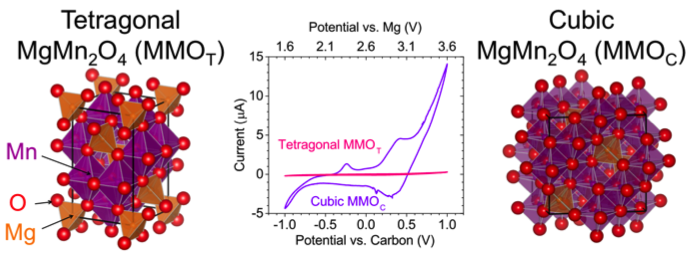
Scientific Achievement
Epitaxial thin film cathodes of MgMn2O4 (“MMO”) are stabilized in two distinct phases (tetragonal vs. cubic) which reveal distinct electrochemical activities for reversible Mg2+ insertion.
Significance and Impact
Results demonstrate a novel strategy for identifying the factors that control multivalent cation mobility in next-generation battery materials.
Research Details
- The tetragonal (MMOT) and cubic (MMOC) phases are stabilized as epitaxial thin films at room temperature although MMOC is otherwise stable only at high temperature or high pressure.
- MMOT films show negligible electrochemical activity, while MMOC exhibits reversible Mg2+ activity.
- The MMOC film undergoes changes to both its structure (e.g., lattice constants) and Mn-oxidation state during charge-discharge processes.
- XPS shows ~ 33% of Mg is extracted upon charging of MMOC
Work was performed at Argonne National Laboratory (JCESR managing partner), University of Illinois at Chicago (JCESR partner) and Northwestern University (JCESR partner) by Z. Feng, X. Chen, L. Qiao, A. Lipson, T. Fister, L. Zeng, C. Kim, T. Yi, N. Sa, D. Proffit, A. Burrell, J. Cabana, B. Ingram, M. Biegalski, M. J. Bedzyk, and P. Fenter.
Research used the Advanced Photon Source at Argonne National Laboratory and the Center for Nanophase Materials Sciences at Oak Ridge National Laboratory, ACS Applied Materials & Interfaces, (2015).

